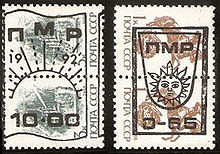Illegal stamp

Illegal stamps are postage stamp-like labels issued in the names of existing independent countries or territories used to defraud postal administrations, stamp collectors, and the general public. Often, but not always, a member nation of the Universal Postal Union (UPU) will have asked the UPU to issue of an "International Bureau Circular" advising others of the illegal stamps. According to the UPU, the market is estimated to be at least $500 million per year.[citation needed]
Illegal stamps are to be distinguished from the many varieties of cinderella stamps which may have some of the same characteristics as illegal stamps but which are not usually issued in the name of an existing country.
Identifying illegal stamps
There is no definitive method to identifying illegal stamp issues.
- Many illegal stamps are issued in the names of countries or territories from Africa or the former Soviet Union, or smaller island nations from around the world. Older illegal issues (from the 1970s) were often in the names of Arab states.
- Most illegal stamps are not listed in the major stamp catalogues, though some may have been included in error or because their status is unclear or because the criteria for entry differ from those used by the UPU to recognise valid stamp issues.
- The WADP Numbering System (WNS), developed by the World Association for the Development of Philately and the UPU, catalogues stamps issued by UPU member nations since 2002. Not all UPU members participate.
Consequences of illegal postage issues
Illegal stamps are said to result in adverse consequences for several different parties. Postal administrations lose revenue to illegal issues and stamp collectors may lose money by mistakenly buying illegal stamps that have little or no monetary value. In addition, inexperienced or non-philatelists have been tricked into buying illegal stamps that are worthless memorabilia for their favorite hobby or interests. Additionally, legitimate stamp dealers may see their market, and the reputation of their industry, eroded by the illegal issues market. Finally, artists and photographers do not receive royalties from artistic work that is used on illegally printed issues.
See also
References
- ^ Murphy, Niall. "PMR Catalogue of USSR Overprints - The "Sun Rays" Group". PMRstamps.org. Retrieved 26 October 2014.
- ^ Murphy, Niall. "PMR Catalogue of USSR Overprints - The "Sun Face" Group". PMRstamps.org. Retrieved 26 October 2014.
External links
- AskPhil.org List of UPU illegal stamp alerts
- AskPhil.org List of issues believed by collectors to be Illegal
- AskPhil labels of Topics/Thematics listed as bogus, unauthorized, not valid for postal use
- UPU illegal stamp circulars link page
- UPU 1996-2003 circulars in pdf
